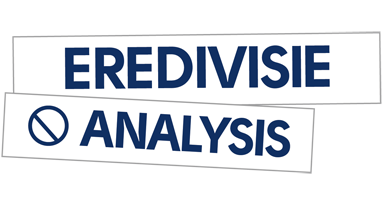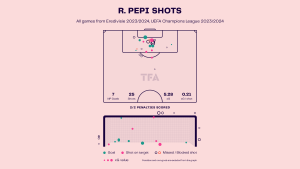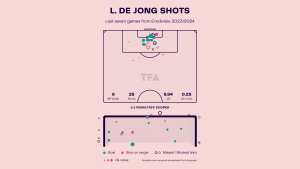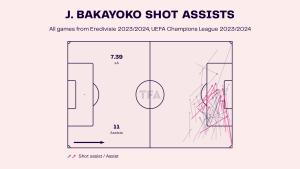Utrecht met Heerenveen at the Stadion Galgenwaard on matchday 4 of the Eredivisie. Heerenveen had made a perfect start to the new season and looked like potential dark horses for the title. Utrecht had had more of a mixed start to the season with a win and draw but were still unbeaten. This meant John van den Brom’s men could draw motivation from the knowledge that a win would catapult them up the table.
The game finished 1-1 with Johnny Jansen’s side being dominated by Utrecht. This tactical analysis seeks to examine the events that led to this scoreline in further detail.
Lineups

Utrecht set up in a 4-2-3-1 formation, an alteration on the 4-3-3 that van den Brom had previously deployed. This suggested that while they weren’t necessarily focused on defending, they were prepared for having to contain their opponents.
Heerenveen began in a 4-4-2 shape with Henk Veerman and Bundesliga champion Bayern Munich loanee Oliver Batista Meier upfront. 18-year-old Arjen van der Heide is becoming a regular fixture in the starting lineup, partnered by 21-year-old Mitchell van Bergen on the opposite wing.
Heerenveen’s quick start
It wasn’t unexpected to see Heerenveen set up in a 4-4-2 shape as this has been the norm this season. However, anyone looking in from the outside may be surprised to see Batista Meier playing as part of a front two rather than on the wing.

The German plays slightly deeper than Henk Veerman, almost as a second striker, due to his superior mobility on and off the ball. This meant that Batista Meier could drop in between the midfield and forward lines to create another option for midfielders. Batista Meier is comfortable when it comes to taking on players so even when he found himself isolated, he was capable of advancing up the pitch.

He also proved useful as part of combination play during the build-up. Not only did he provide an additional passing option, but Heerenveen could elect to play a ‘bounce pass’ to him which would afford the winger additional time to advance.
This extra time to advance further up the pitch was particularly effective on the right-hand side. Van Bergen appeared far more confident than van der Heide in 1v1 situations, allowing him to make more use of the extra yards gained.

Central midfielders Joey Veerman and Rodney Kongolo would push up during attack with at least one occupying the corresponding half-space. This allowed van Bergen and van der Heide to remain wide, stretching the Utrecht defence and creating exploitable gaps.

It was through this method that Heerenveen were able to take the lead. As the above image shows, van Bergen stays wide and Veerman attacks through the middle. The position of van Bergen means that Django Warmerdam and Justin Hoogma are both faced with trade-offs.
Warmerdam can position himself wider to prevent a through ball to van Bergen, but risk leaving exploitable space between himself and Hoogma. Similarly, Hoogma can follow Warmerdam wider to try and reduce the gap between the two, or risk leaving space to his right for a through ball to Veerman. In this situation, the two get their distances wrong meaning it’s easy for Veerman to finish a 1v1 against the keeper.

There was also positional rotation from Heerenveen in some attacks. In the above picture, van Bergen is vacating his wide position to come into a more central area. This movement drags Warmerdam inside with him, allowing right-back Sherel Floranus to move into a spacious wide area.

Due to the fact that none of Utrecht’s central players had been tasked with marking van Bergen, he was free to receive the ball in acres of space. Heerenveen weren’t able to make the most out of this tactic, with van Bergen hitting the bar being as close as they came to scoring.
Despite their strong start, Heerenveen’s attacking threat faded as the game went on. They only reached the opposition penalty area 9 times, 20 less than Utrecht (WyScout) who would dominate going forward.
Utrecht’s initial attacking tactics
Around the half-hour mark, Utrecht stepped up their game in attack. They began pressing at a higher intensity and creating more chances, looking to be a real threat.

Utrecht pressed the opposition in similar shapes in wide areas on both sides. The striker and corresponding wide midfielder would press the man on centre back and full-back respectively.

Gustafson and the corresponding defensive midfielder would support the press by condensing the space in front to play into and marking other options. This made it difficult for Heerenveen to play out of defence as, other than making long passes or going backwards, the centre backs had no options.
When going forward, wide midfielders Bart Ramselaar and Gyrano Kerk would tuck inside vacating space for an overlapping full-back.
In more advanced situations where Utrecht’s wide midfielders had formed a three with Mimoun Mahi in attack, Utrecht would bring Simon Gustafson into the attack.

Mahi would stay on the defensive line to try and pin them in position. Meanwhile, a winger (or in this case full-back) would pull an opposition full-back or winger out wide, leaving space for Gustafson to advance into.

This is dangerous as, providing Utrecht are able to find Gustafson, he has space and time in a very advanced area of the pitch. As a result, he is afforded with the opportunity to pass, shoot, cross or attempt to take on an opponent.

Utrecht’s crossing approach was made possible due to the narrowness of the Heerenveen defence. At times this left a whole channel free for the full-back to control in the ball before crossing.
Crossing isn’t the most effective form of attack and this was proven by the fact that only one in every three of Utrecht’s crosses was accurate (WyScout). However, probability suggests that even tactics that are rarely effective can be successful given enough attempts, which was the danger for Heerenveen.
Shockingly though, despite managing 33 total crosses Utrecht weren’t able to make the most of any of their chances.

With that being said, Utrecht’s equalising goal was assisted from a wide area by full-back Mark van der Maarel. It was a short pass rather than a cross, however depending on who you ask and their definition of a cross, it may be seen as an example of a successful cross. Regardless, the point is that Utrecht did manage to successfully utilise the space in these wide areas to their advantage.
Heerenveen’s retreat
Heerenveen haven’t been used to lacking control in games this season due to their 100% record in the league. However, this was a situation that Heerenveen were confronted with in the second half. They began playing more and more long balls and looking less comfortable, whereas their opponents were creating chances in the final third after playing out.

Recognising that the momentum in the game was changing, Heerenveen began playing a deeper defensive line and putting more men behind the ball.

This is particularly apparent when looking at the average positions of the defensive line and how deep they are. This was due to the fact that other than during the opening period, Heerenveen were focused on containing Utrecht.

WyScout’s pressing statistics show that Heerenveen’s pressing at the start of the second half was pretty much non-existent. De Superfriezen sat back and invited the opposition onto them, a challenge that Utrecht willingly accepted.
It can be inferred that Johnny Jansen had been aiming to use this period to get the game under control again. Unfortunately for Heerenveen, they never really regained full control.
Utrecht’s domination
During the final 30 minutes, Utrecht managed to produce wave after wave of attacks. This was in part due to Kerk’s ability to break lines and advance into space with the ball.

He successfully completed 10 dribbles, more than any other player on the pitch (WyScout) and was instrumental in the quick attacks that created so many chances for Utrecht.

As well as pressing wide areas and with the front 3 (or 4 including Gustafson), defensive midfielder Adam Maher assisted in winning the ball back in the opposition half. Maher recovered the ball 13 times and was vital when it came to transitioning quickly back into attack.

Utecht’s rate of 0.53 recoveries per minute (WyScout) meant that the now defensive Heerenveen were finding themselves unable to play out of defence. They were suffering as a result of Utrecht’s new pressing system and by the end of the game had lost the ball 37 times in their own half.

If Heerenveen’s focus hadn’t been defensive before, the change of shape into a 4-2-3-1 formation was all the proof needed to show that they were struggling. Utrecht managed a total of 35 shots (albeit with only 7 of them on target). Things only got worse for Heerenveen after the sending off of Rein Smit. They looked to be truly clinging onto a point with two lines of four behind the ball and Ulysses Llanez left alone up front.
In the end, Heerenveen did (somehow) hold out. Utrecht’s inability to convert during late goalline scramble that in total had been expected to produce 1.00 goals (WyScout) summed up the evening in almost perfect fashion.
Conclusion
From both a statistical and qualitative point of view, Utrecht should have won this game. Their xG by the end of the game was 4.40 and even ignoring the quality of chances, it’s astonishing that a side who created as many as they did were unable to score more than once. Utrecht are clearly confident in attack but going forward John van den Brom’s team will need to focus on making the most out of the chances that they create.
After their perfect start to the season, Heerenveen will undoubtedly be disappointed at dropping points here. This analysis suggests that perhaps Heerenveen won’t be challenging for the title this season. However, other than in this game they have done well to consistently beat lower and mid-table sides. Providing they carry on in similar form, it would surprise me if we didn’t see Heerenveen in the mix for European places come the end of the season.









